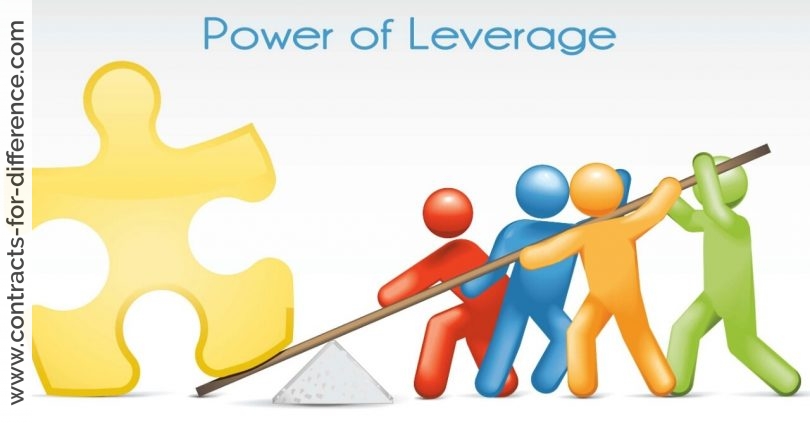Q:What is gearing (or leverage)?
A: Hedge funds use it, so do a number of exchange-traded and investment funds. Daytraders too. Leverage (or gearing as it is sometimes referred to) is much like borrowing: it allows you to increase your potential return on a trade as you increase your exposure to the market.Gearing, as in the mechanical sense, is the process of turning a small effort into a large output (examples: in a lever or in a bicycle’s gears. In financial terms gearing has the same effect: it enables a customer to trade a position in much larger size than the margin that is deposited with the CFD broker, e.g. For an initial deposit of £1,000, a customer can buy or sell £10,000 of a FTSE 100 share (This is ‘gearing’ or leverage of 10:1). Gearing when used this way is also sometimes referred to as investment gearing.
Leverage is the ability to trade a large position (i.e. a large number of shares, or contracts) with only a small amount of trading capital (i.e. margin).
CFDs allow you to speculate on rises and falls in stocks, currency pairs and other assets while only putting up a small amount of your own money. You are leveraging off the money you do have, in the hope of making more. Gearing (another word for leverage) in CFDs enables traders with a small float to make good profits from trading the stock market. In other words, gearing or leverage magnifies investment returns and can even help you diversify a trading portfolio as it frees up capital which can then be deployed in other investments. For instance your trading system might be designed to make a 25% return per annum. With a $5000 float, this would produce $1500 in profit in one year. However with CFDs because of the gearing the same system could potentially make a 300% return, which would be $15 000 profit in one year. But it is important to understand that gearing (leverage) is a double-edged sword and an asset can fall as well as rise thereby potentially magnifying your losses.
| Account Value | Margin | Leverage factor | Maximum Exposure |
| $10,000 | 5% | 20:1 | $200,000 |
| $10,000 | 10% | 10:1 | $100,000 |
| $10,000 | 20% | 5:1 | $50,000 |
| $10,000 | 50% | 2:1 | $20,000 |
With CFDs, you only have to put in a fraction of the market value of the underlying asset when making a trade, sometimes as little as 5%. The remaining 95% of the value of the asset is covered by the CFD provider. Despite only outlaying a fraction of the face-value of a trade, the CFD trader’s account balance will still reflect the financial impact of movements for or against the full sized position. In other words, even though you originally only put up 5% of the value of the market position, you are still entitled to the same gains or losses as if you had paid 100%. This is great if prices move in the anticipated direction. If trading a share on a margin of 5%, a price rise of 1% in the underlying market could deliver gains of 20% on a long CFD position. However, if prices moved against the CFD position by 1%, it could result in a loss of 20% of the amount initially outlaid as margin. If CFD traders overlook this feature of trading on margin, they risk making the mistake of taking on too much risk.
Q:Is leverage good or bad?
A: Leverage represents an efficient way to use trading capital and many professional traders value this investment property precisely because it empowers them to trade larger positions (more contracts, stocks..etc) with less trading capital. Leverage by itself does not change the potential profit or loss on a trade. What it does is to reduce the amount of trading capital that must be tied to open trading positions, releasing trading capital which can be utilised for other trades in the process. For instance, a CFD trader that wanted to buy 1000 shares of stock at $25 per share would only need perhaps $2500 of trading capital (10% margin requirement), leaving $20,000 available to open additional trades. That’s the way professional traders look at leverage.It is also worth nothing that in addition to being an efficient use of trading capital, gearing or leverage can also help reduce the total amount at risk for certain types of trades. For instance, a trader that wanted to invest in 10,000 shares at $10 per share would need $100,000 to have this exposure in a traditional shares portfolio and all this would be at risk. However a trader that wanted this exact exposure in the same share with exactly the same potential upside or loss (i.e. a tick value of $100 per 0.01 change in price) using the warrants markets might only need a fraction of this amount, say, $5,000 and only this amount would be at risk. Another aspect worth noting is that leverage allows for greater diversification as it allows you to open multiple positions across different assets with a limited amount of capital (as opposed to buying only one share).
Professional traders will choose highly leveraged markets over non-leveraged markets every time.
Leverage make CFDs very attractive as a trading product. But because you are trading with leverage, the gains and losses are magnified – and the risks are much greater – use leverage with care!
Q:Do all CFDs have the same level of leverage, what is the leverage?
A: No, it varies widely – depending mainly on the volatility and liquidity of the underlying markets. The actual percentage of the margin (i.e. market value) that you will be requested to put in will also vary for different CFD providers.In practice, initial margins can range from as low as 1% to as high as 75% depending on the specific instrument. Most share CFDs in the ASX 300 and FTSE 100 are around the 5% or 10% mark whereas for small caps the initial margin requirementd would more likely to be in the 25% to 50% range. If you are looking at foreign exchange then you can get much higher levels of gearing (normally starting at just 1%) simply because stocks are much more volatile whereas a currency moving high in value in a short-time period is relatively unlikely; although it has happened recently with a number of currency pairs so it very much depends on the product that you are trading. Likewise for the indices margins start at 1% of the overall exposure. A number of CFD providers also use a margin-based system wherby the margin required would depend on the stop loss level; so while a trader buying one CFD on the Dow might normally have to put up $350 as margin, the margin required for this same position would go down to just $100 if a 100-point stop loss is built into the position.
Q:Just wondering what the effect is in comparison to small leverage say 3/1 and then more 5/1 10/1 and more.
How does it effect your position in trades? Also, what the difference is in how one reacts to the high gearing situation, much more risk I know.
A: In forex, if you are using 1:1 leverage , and your trade moves 3%, your account will go up or down 3%. With 5:1 leverage , when your trade moves 3%, your account will change 15%. With 10:1 leverage, your account will change 30%.If you do not want to use leverage and only want to use 1:1 then your position size should not exceed than what the balance of your account is. For instance if you have an account balance of $10,000 and you make a trade for $10,000 then you are not leveraged.
The way high gearing effects traders is the emotional reaction a trader has because such a large percentage of their account is on the line. Greed and fear are the usual reactions.
How this applies to the technical aspect of the trade is that to follow proper money management , you will be forced to really tighten your stops. Higher gearing (i.e. leverage) means a bigger position size. Which follows that to keep your maximum loss of say 2% per trade, you would need to place a really tight stop. But it is important that you do not place a stop loss just because that point is where you are not prepared to risk more money. You first need to make sure you are looking for a support level and then decide on the amount of money you are willing to risk or lose if you make it to that level and lastly set your share size accordingly. Make sure you don’t just pick a spot and say ‘well here I will be losing $500 so I need to make that my stop loss ‘.


Leave a Comment